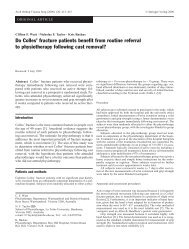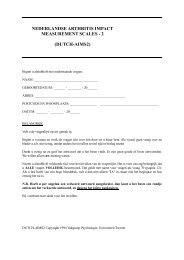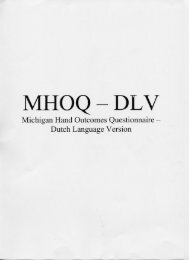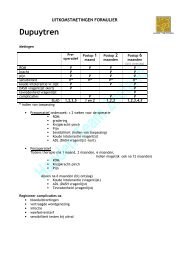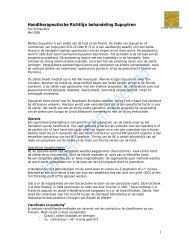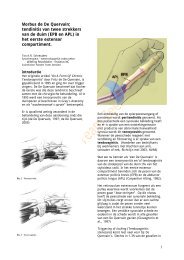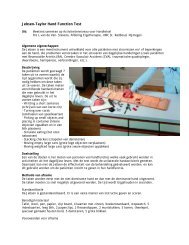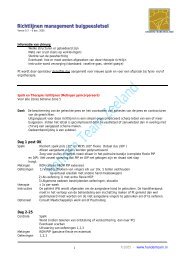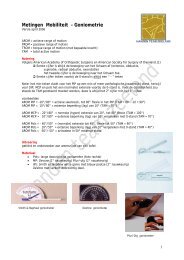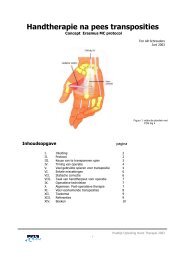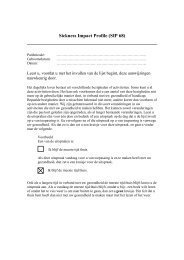Muscle strength measurements of the Hand - Handen Team Zeeland
Muscle strength measurements of the Hand - Handen Team Zeeland
Muscle strength measurements of the Hand - Handen Team Zeeland
Create successful ePaper yourself
Turn your PDF publications into a flip-book with our unique Google optimized e-Paper software.
Ton A.R. Schreuders, JW Brandsma, HJ Stam<br />
<strong>the</strong> metacarpo-phalangeal (MCP) joint.<br />
The first palmar interosseous (1 PI)<br />
muscle is more active in tip pinch<br />
activities.<br />
In Type II, <strong>the</strong> insertion into <strong>the</strong><br />
lateral band <strong>of</strong> <strong>the</strong> extensor apparatus (d.)<br />
is responsible for an important extension<br />
force at <strong>the</strong> proximal interphalangeal (PIP)<br />
joints. The first palmar interosseous also<br />
produces some supination <strong>of</strong> <strong>the</strong> index<br />
finger to get good approximation <strong>of</strong> <strong>the</strong><br />
pulps. In this respect we might consider<br />
<strong>the</strong> 1 PI as an “opponens indices” muscle<br />
in tip pinch activities.<br />
Without interossei <strong>the</strong> finger is<br />
unstable and will collapse into <strong>the</strong> “claw”<br />
(i.e. intrinsic minus) position <strong>of</strong> flexed IP<br />
joints and (hyper-) extension <strong>of</strong> <strong>the</strong> MCP<br />
joint: <strong>the</strong>refore <strong>the</strong> interosseous are<br />
sometimes referred to as <strong>the</strong> “anti-claw”<br />
muscles. 35 The primary function <strong>of</strong> <strong>the</strong><br />
interossei is MCP flexion/stabilisation with<br />
extension <strong>of</strong> <strong>the</strong> interphalangeal (IP) joints.<br />
This is especially evident during pinch in<br />
which <strong>the</strong> collapse <strong>of</strong> <strong>the</strong> index PIP joint is<br />
apparent in, <strong>of</strong>ten > 90°, flexion. This is a<br />
sign <strong>of</strong> interosseous muscle weakness<br />
and sometimes referred to as <strong>the</strong><br />
Mannerfelt sign. 20 (Figure 2).<br />
FIGURE 2. Mannerfelt and Froment sign on<br />
left hand <strong>of</strong> patient with ulnar nerve paralysis.<br />
Recording <strong>the</strong> moments <strong>of</strong> <strong>the</strong><br />
intrinsic muscles that were generated after<br />
electrical stimulation Lauer et al. 43 found<br />
that <strong>the</strong> dorsal interossei muscles were<br />
strong abductors <strong>of</strong> <strong>the</strong> fingers and<br />
generated a significant moment in MCP<br />
joint flexion and IP joint extension.<br />
Similarly, Ketchum et al. 34 found that <strong>the</strong><br />
interossei muscles <strong>of</strong> <strong>the</strong> index finger<br />
contribute 73% to <strong>the</strong> overall moment for<br />
flexion <strong>of</strong> <strong>the</strong> MCP joint. 34 Li et al. 44<br />
investigated <strong>the</strong> role <strong>of</strong> <strong>the</strong> intrinsic finger<br />
flexor muscles during finger flexion tasks.<br />
When an external force is applied<br />
proximally to <strong>the</strong> PIP joint, <strong>the</strong> extensor<br />
mechanism (intrinsic muscle group) is <strong>the</strong><br />
largest component (70%) on force<br />
production <strong>of</strong> all flexors.<br />
Thus <strong>the</strong> interossei muscles are<br />
important flexors <strong>of</strong> <strong>the</strong> MCP joint toge<strong>the</strong>r<br />
with <strong>the</strong> long flexors: flexor digitorum<br />
pr<strong>of</strong>undus (FDP) and flexor digitorum<br />
superficiales (FDS). However, at <strong>the</strong> PIP<br />
joint level <strong>the</strong> long flexors, primarily <strong>the</strong><br />
FDS, and <strong>the</strong> interossei are antagonists.<br />
When <strong>the</strong> PIP joint is flexed, some<br />
reduction <strong>of</strong> <strong>the</strong> extension moment <strong>of</strong> <strong>the</strong><br />
interossei takes place, due to <strong>the</strong> volar<br />
displacement <strong>of</strong> <strong>the</strong> lateral bands (<strong>of</strong> about<br />
4-mm) at <strong>the</strong> PIP joint level. At full flexion<br />
<strong>of</strong> both <strong>the</strong> PIP and distal interphalangeal<br />
(DIP) joints, <strong>the</strong> lateral bands approach<br />
<strong>the</strong> flexion-extension axis <strong>of</strong> <strong>the</strong> PIP joint,<br />
<strong>the</strong>reby minimising <strong>the</strong> extensor moment. 2<br />
The action <strong>of</strong> <strong>the</strong> interossei<br />
muscles can be studied separately from<br />
<strong>the</strong> extensor digitorum communis (EDC)<br />
muscles in patients with a radial nerve<br />
paralysis. If <strong>the</strong> patient is asked to extend<br />
<strong>the</strong> fingers, no extension <strong>of</strong> <strong>the</strong> MCP will<br />
occur, but <strong>the</strong> finger IP joints will extend<br />
because <strong>of</strong> <strong>the</strong> ulnar and median nerve<br />
innervated interosseous and lumbrical<br />
muscles. However, in some patients <strong>the</strong><br />
fingers, especially <strong>the</strong> index, can be<br />
extended in <strong>the</strong> MCP joint to some degree,<br />
especially with <strong>the</strong> wrist flexed; this is<br />
probably because <strong>the</strong> angle <strong>of</strong> attachment<br />
<strong>of</strong> <strong>the</strong> dorsal interossei muscles is only 0°-<br />
5°. When <strong>the</strong> tension on <strong>the</strong> extensor<br />
tendon is increased due to <strong>the</strong> flexed wrist,<br />
this angle will go beyond <strong>the</strong> 0° and thus<br />
<strong>the</strong> interosseous muscle becomes an<br />
extensor <strong>of</strong> <strong>the</strong> MCP joint. The angle <strong>of</strong><br />
approach to <strong>the</strong> extensor mechanism for<br />
<strong>the</strong> palmar interossei muscles is 20°-25°<br />
and for <strong>the</strong> lumbrical muscles 35°. 28<br />
The index finger is deprived <strong>of</strong> all<br />
long flexors and <strong>the</strong> lumbrical muscles in<br />
patients with a high median nerve<br />
paralysis. The only active muscles are <strong>the</strong><br />
long extensors and <strong>the</strong> two interossei. In<br />
6



